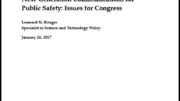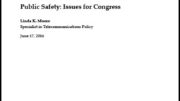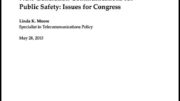Linda K. Moore
Specialist in Telecommunications Policy
March 12, 2014
Summary
Since September 11, 2001, when communications failures contributed to the tragedies of the day,
Congress has passed several laws intended to create a nationwide emergency communications
capability. Yet the United States has continued to strive for a solution that assures seamless
communications among first responders and emergency personnel at the scene of a major disaster.
To address this problem, Congress included provisions in the Middle Class Tax Relief and Job
Creation Act of 2012 (P.L. 112-96) for planning, building, and managing a new, nationwide,
broadband network for public safety communications (FirstNet), and assigned additional radio
frequency spectrum to accommodate the new network. In addition, the act has designated federal
appropriations of over $7 billion for the network and other public safety needs. These funds will
be provided through new revenue from the auction of spectrum licenses. These and other public
safety and spectrum provisions of the act appear in Title VI, known as the Public Safety and
Spectrum Act, or Spectrum Act.
There are many challenges for public safety leaders and policy makers in establishing the
framework for a nationwide network that meets state, local, and tribal needs for robust,
interoperable emergency communications. For example, emergency communications networks
currently operate on separate networks using different technologies. Because public safety
planning has lagged behind commercial efforts to build next-generation wireless networks, the
work on design and development of technical requirements for a public safety broadband network
is incomplete. Furthermore, each state has its own laws and procedures for building, managing,
and funding its network. Establishing a governance model that accommodates current
investments and future needs without compromising the coherence of a national network is
another challenge. The cost of construction of a nationwide network for public safety is estimated
by experts to be in the tens of billions of dollars over the long term, with similarly large sums
needed for maintenance and operation. In expectation that private sector participation in building
the new network will reduce costs to the public sector, the law has provided some requirements
and guidelines for partnerships, access to spectrum, and shared use of infrastructure. Identifying
and negotiating with potential partners is another challenge for the new network, as is
establishing a revenue stream to fund operations and future investments.
These and other challenges are potential barriers to the success of the new network. To meet them
in a timely manner may require significant investments in human resources in the early stages of
the network. Therefore, yet another challenge to success may arise from federal hiring
requirements and the release of funds to cover salaries and expenses while FirstNet is in start-up
mode.
In addition to monitoring progress in building the new broadband network for public safety,
Congress may want to consider reviewing the role of commercial networks in emergency
response and recovery. Once commercial communications lines are compromised because of
infrastructure failures, interdependent public safety networks are threatened and the ability to
communicate vital information to the public is diminished. New policy initiatives may be needed
to identify critical gaps in communications infrastructure and the means to fund the investments
needed to close these gaps.





Be the first to comment on "The First Responder Network (FirstNet) and Next-Generation Communications for Public Safety: Issues for Congress 2014"